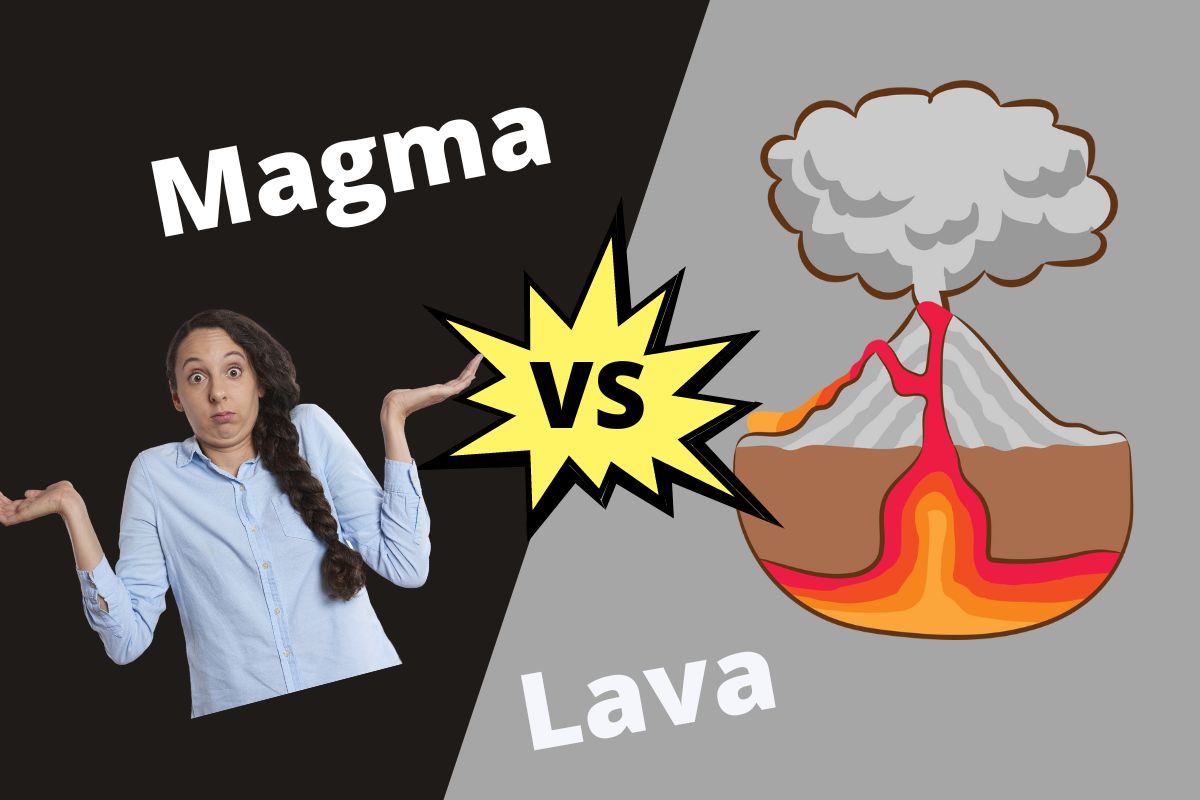Magma consists of molten rock and is stored in the earth’s crust. In contrast, lava is the magma that flows to the earth’s surface through volcanic vents. In simple terms, magma remains stagnant while lava flows through.
We often use the words magma and lava to describe the liquid that erupts from volcanoes. These terms actually refer to two different things.
Table of Contents
What is the Difference Between Magma and Lava?
| Magma | vs | Lava |
| Magma is a molten rock found in the earth’s crust | Definition | When magma reaches the earth’s surface, it’s called lava |
| Magma is a Greek word | Origin of the terminologies | Lava is an Italian word |
| Earth’s crust | Geography | Earth’s surface |
| 1300 to 2400 degrees Fahrenheit | Temperature | 1300 to 2200 degrees Fahrenheit |
| Andesitic, Basaltic, and Rhyolitic | Types | Aa flow, Pahoehoe flow, Pillow lava flow, Blocky lava flow |
| Minerals and a minimal amount of gasses like sulfur and carbon dioxide | Composition | Has chemical elements, glasses, crystals, bubbles, and liquid |
| Magma takes longer cooling times because it remains inside of the earth. | Cooling time | Lava takes less cooling time and turns into black rocks once it cools down. Lava sometimes also leads to the crystallization of glass. |
What is Magma?
The term magma is an ancient Greek word that means thick balm or ointment. Magma is a molten or boiling semi-liquid or liquid rock found on the earth’s surface.
Magma remains in the mantle layer of the earth. When it pushes through the other layers of the world, it creates a hole resulting in volcanic eruptions.
Magma is often found under the magma chambers. It’s hot and contains minerals and gases like carbon dioxide, water vapor, sulfur, suspended crystals, aluminum oxide, titanium, manganese, sodium, etc.
The temperature of magma can range from 1300 to 2400 degrees Fahrenheit, and it depends on several factors, such as the area’s climatic conditions.
Viscosity’s Role
The viscosity of magma influences the volcano’s shape and can also result in its eruption. When the magma is too viscous, it will create steep slopes of volcanoes. When it has a thinner consistency, the volcano will be flatter.
Three Types of Magma
Magma is further classified into three types – Andesitic magma, Basaltic magma, and Rhyolitic magma. The mineral composition in all these three types is different. Still, each of them has a varying percentage of silicon dioxide.
Basaltic Magma
Basaltic magma contains a high amount of magnesium, calcium, and iron but is low in potassium and sodium. The temperature of Basaltic magma ranges from 1832 to 2192 degrees Fahrenheit.
Andesitic Magma
Andesitic magma doesn’t contain a very high amount of these minerals. The temperature of Andesitic magma ranges from 1472 to 1832 degrees Fahrenheit.
Rhyolitic Magma
Rhyolitic magma contains the highest amount of potassium and sodium compared to the other two types. It’s low on calcium, iron, and magnesium. Rhyolitic magma has a temperature range of 1202 to 1472 degrees Fahrenheit.
Mafic Magma
Some magmas, like the mafic magma, form when the heavier crusts that form the ocean floor start melting. Mafic magma is the hottest among all magmas, with temperatures rising to 2200 degrees Fahrenheit.

What is Lava?
Lava is an Italian word that means stream or torrent. Lava occurs when the hot magma flushes out of the earth’s surface through volcanic vents. A volcano vent allows a semi-liquid molten rock that keeps flowing through. The temperature of the lava can be very high, anywhere between 1300 to 2200 degrees Fahrenheit.
When this boiling lava cools down, it turns into black rocks. Lava can be very thick or it can flow easily. Its viscosity depends on the amount of silica present within it.
Lava contains minerals and gases like- oxygen, silicon, iron, potassium, calcium, magnesium, etc. To know the types of lava, you must learn from which volcano it has emerged.
Types of Lava
Aa Lava
Aa lava is exceptionally rough. The surface of Aa lava has loose irregular fragments called clinkers. Aa lava results from rivers of liquid lava, which can be 8 to 15 meters wide.
Pahoehoe Lava
Pahoehoe lava has a smooth, gently flowing, and hummocky surface. The flowing lava takes the shape of a twisted rope. Pahoehoe and Aa lava has the same chemical composition. It’s sometimes possible for Pahoehoe lava to transform into Aa lava as it flows downslope.
Pillow Lava
Pillow lava results from low viscosity magma like the basalt when it erupts underwater. It looks like volcanic rock.
Block Lava
Block lava looks like a top with loose rubbles and occurs in fragments. But the fragments have quite prominent shapes. Block lava is formed by intermediate or andesitic lava.

Are There Any Similarities Between Magma and Lava?
Yes, lava and magma have the same minerals because they are the same thing with different states or geographies. Magma remains inside the earth while lava remains on the outside, mainly due to volcanic eruptions.
The key difference lies in their geography. Lava remains on the earth’s surface while magma remains inside the earth’s crust.
If you’ve enjoyed this post, check out our blog exploring the difference between the sea and ocean.

